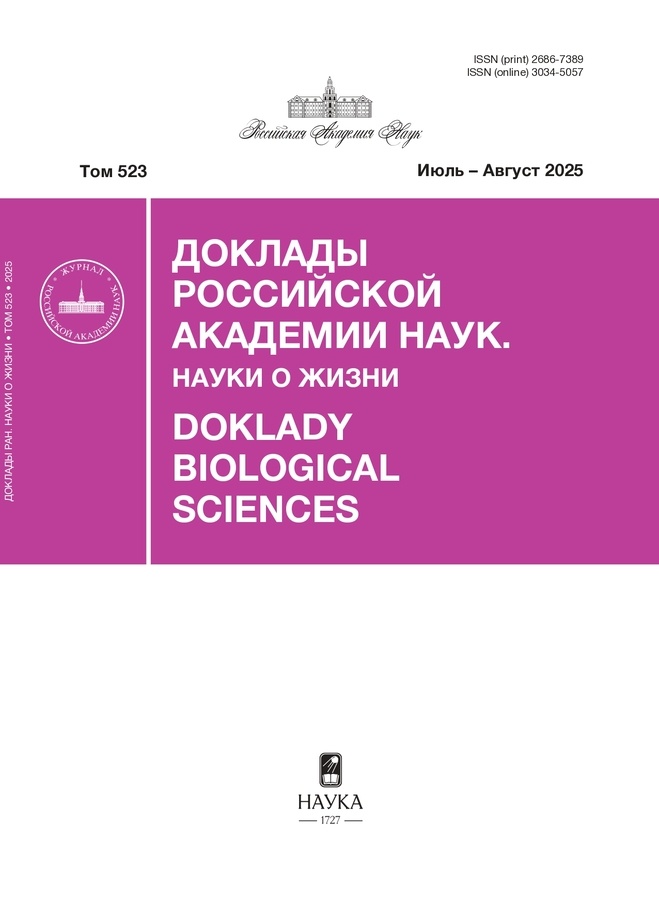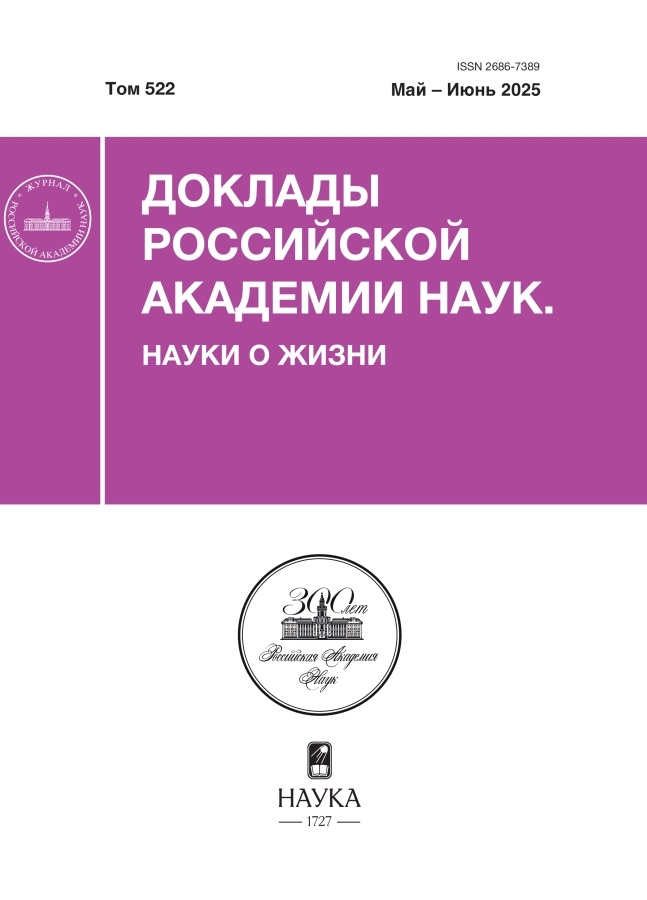Роль водных экосистем как источника омега-3 полиненасыщенных жирных кислот для прыткой ящерицы Lacerta agilis (Linnaeus, 1758), обитающей в околоводном биотопе
- Авторы: Дименко О.С.1, Рудченко А.Е.1,2, Борисова Е.В.1, Тупикова А.Д.1, Сущик Н.Н.1,2
-
Учреждения:
- Сибирский федеральный университет
- Федеральный исследовательский центр “Красноярский научный центр Сибирского отделения Российской академии наук”
- Выпуск: Том 522, № 1 (2025)
- Страницы: 330-334
- Раздел: Статьи
- URL: https://jdigitaldiagnostics.com/2686-7389/article/view/686365
- DOI: https://doi.org/10.31857/S2686738925030038
- ID: 686365
Цитировать
Полный текст
Аннотация
Изучен состав и содержание жирных кислот прыткой ящерицы Lacerta agilis и ее потенциальных пищевых объектов в околоводном и степном биотопах. Впервые установлено, что в тканях ящериц из околоводного биотопа в период вылета амфибионтных насекомых из близлежащего соленого озера Шира значительно возрастает содержание длинноцепочечных омега-3 полиненасыщенных жирных кислот, в первую очередь эйкозапентаеновой кислоты (ЭПК). Среди всех пищевых источников ящериц максимальное содержание ЭПК было у имаго хирономид. Содержание докозагексаеновой кислоты (ДГК) в мышцах ящериц также было высоким, хотя данная кислота не была обнаружена в беспозвоночных, потребляемых в пищу. В этой связи выдвинуто предположение о способности прыткой ящерицы к биосинтезу ДГК из биохимических предшественников, содержащихся в пище.
Полный текст
Об авторах
О. С. Дименко
Сибирский федеральный университет
Email: arudchenko@sfu-kras.ru
Россия, Красноярск
А. Е. Рудченко
Сибирский федеральный университет; Федеральный исследовательский центр “Красноярский научный центр Сибирского отделения Российской академии наук”
Автор, ответственный за переписку.
Email: arudchenko@sfu-kras.ru
Институт биофизики Сибирского отделения Российской академии наук
Россия, Красноярск; КрасноярскЕ. В. Борисова
Сибирский федеральный университет
Email: arudchenko@sfu-kras.ru
Россия, Красноярск
А. Д. Тупикова
Сибирский федеральный университет
Email: arudchenko@sfu-kras.ru
Россия, Красноярск
Н. Н. Сущик
Сибирский федеральный университет; Федеральный исследовательский центр “Красноярский научный центр Сибирского отделения Российской академии наук”
Email: arudchenko@sfu-kras.ru
Член-корреспондент РАН, институт биофизики Сибирского отделения Российской академии наук
Россия, Красноярск; КрасноярскСписок литературы
- Гладышев М.И. Незаменимые полиненасыщенные жирные кислоты и их пищевые источники для человека // Журнал Сибирского федерального университета. Биология. 2012. Т. 5. №4. С. 352–386.
- Gladyshev M.I., Sushchik N.N., Makhutova O.N. Production of EPA and DHA in aquatic ecosystems and their transfer to the land // Prostaglandins & Other Lipid Mediators. 2013 V. 107. P. 117–126.
- Muehlbauer J.D., Collins S.F., Doyle M.W., et al. How wide is a stream? Spatial extent of the potential “stream signature” in terrestrial food webs using meta‐analysis // Ecology. 2014. V. 95. №11. P. 44–55.
- Sabo J.L., Power M.E. River-watershed exchange: effect of riverine subsidies on riparian lizards and their terrestrial prey // Ecology. 2002. V. 83. № 7. P. 1860–1869.
- Gladyshev M.I., Makhrov A.A., Baydarov I.V., et al. Fatty acid composition and contents of fish of genus Salvelinus from natural ecosystems and aquaculture // Biomolecules. 2022. V. 12(1). P. 144.
- Vitkovskaya I.A., Borisova E.V., Sushchik N.N. Dispersal of Midges (Chironomidae, Diptera) on terrestrial area after the emergence from saline Lake Shira // Journal of Siberian Federal University. Biology. 2019. V. 12. №2. P. 216–226.
- Demina I.A., Shulepina S.P., Ageev A.V., Sushchik N.N. Characterization of zoobenthos and export of biomass and polyunsaturated fatty acids due to emergence of midges (Diptera, Chironomidae) from three saline lakes of South Siberia // Journal of Siberian Federal University. Biology. 2022. V. 15. №4. P. 507–528.
- Chari L.D., Richoux N.B., Villet M.H. Dietary fatty acids of spiders reveal spatial and temporal variations in aquatic-terrestrial linkages // Food Webs. 2020. V. 24. e00152.
- Fritz K.A., Kirschman L.J., McCay et al. Subsidies of essential nutrients from aquatic environments correlate with immune function in terrestrial consumers // Freshwater Science. 2017. V. 36. №4. P. 893–900.
- Castro L.F.C., Tocher D.R., Monroig O. Long-chain polyunsaturated fatty acid biosynthesis on chordates: Insights into the evolution of Fads and Elovl gene repertoire // Progress in Lipid Research. 2016. V. 62. P. 25–40.
- Davis‐Bruno K., Tassinari M. S. Essential fatty acid supplementation of DHA and ARA and effects on neurodevelopment across animal species: a review of the literature // Birth Defects Research Part B: Developmental and Reproductive Toxicology. 2011. V. 92. №3. P. 240–250.
- Speake B.K., Thompson M.B. Comparative aspects of yolk lipid utilisation in birds and reptiles // Poult Avian Biol Rev. 1999. V. 10. P. 181–211.
- Walzem R.L. Lipoproteins and the laying hen: form follows function // Poult. Avian Biol. 1996. Rev. 7. P. 31–64.
- Дгебуадзе Ю. Ю., Неймарк Л. А., Башинский И. В., и др. Роль обыкновенного ужа Natrix natrix (Reptilia, Colubridae) в переносе полиненасыщенных жирных кислот из водных экосистем на сушу // Доклады Российской академии наук. Науки о жизни. 2023. Т. 513. №1. С. 599–603.
Дополнительные файлы













